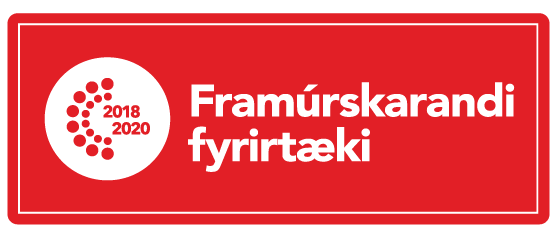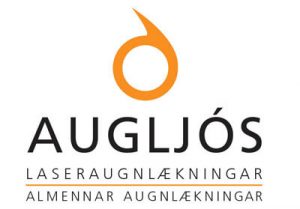Augljos Refractive Surgery Clinic
Information on the LASIK procedure.
Please read this carefully before you have the operation performed.
Dr. Kristinsson at the Augljos Refractive Surgery Center has performed laser refractive surgery since the turn of the century. Thousands of patients have experienced new vision and new possibilities in life without the aids of glasses or contact lenses. We offer only the very best in technology and patient care. Our staff speaks English fluently and our service is unsurpassed. We personally guarantee you that our laser refractive treatment is second to none and will do everything to make your visit to our eye clinic a memorable experience.
Augljos Laser Vision Correction
LASIK and other forms of refractive laser treatments use pulses of invisible, ultraviolet light to remove a very thin layer from the front surface of the eye, changing the curvature of the cornea. To correct nearsightedness, the curvature of the cornea must be decreased, which means that the cornea must be made flatter. To correct farsightedness, the curvature of the central cornea must be increased, which is accomplished by removing a “donut” shaped ring of tissue. To correct astigmatism, the curvature must be altered in one specific direction.
Only a very small amount of material is removed, usually less than the thickness of a hair. Low amounts of nearsightedness, farsightedness, or astigmatism will require smaller amounts of tissue removal, and larger corrections will require greater amounts. The total treatment usually takes less than one minute of actual laser time. The total time of the operation is usually under 5 minutes each eye.
A computer running specialized software determines the exact pattern of pulses needed to remove the right amount of corneal tissue. The computer also directs the actual operation of the laser system.
There are several variations of laser vision correction, each of which has advantages and disadvantages. We will discuss your specific situation with you after we have taken your personal history and performed measurements and calculations.
LASIK (LASer In-situ Keratomileusis). This is our most common type of treatment, accounting for over 90% of the operations.
A protective flap is made using the keratome. The treatment is then applied under the protective flap. LASIK treatment allows for the most rapid visual recovery. Usually both eyes are treated at the same time. Postoperatively, the eyes recover quickly, usually with a visual acuity of 20/20 or better the day after without any corrective lenses.
LASIK without a flap (PRK, LASEK). For patients with extremely dry eyes, thin corneas, large pupils, very high corrections or a combination of these, laser refractive surgery without a flap may be the best treatment. Rather than making a protective flap, the laser treatment is applied directly under the ultra-thin tissue layer (known as the epithelium) that covers the front surface of the eye. There are many minor variations in how the tissue layer is handled: if the layer is completely removed, then the procedure is called PRK (photorefractive keratectomy); if it is laid back over the treatment area, the technique is called LASEK. In either one of these methods, the tissue layer grows back in 5-7 days, during which time the vision is blurry and a protective contact lens must be worn. Usually, this treatment can be used on both eyes the same day.
In addition, we offer both so-called conventional and customized treatment (wavefront or third-generation laser) on our patients. The decision on which treatment to use is based on our thorough examination on patients.
We offer treatment with a 2012 edition of the distinguished Schwind Amaris, a top-of-the-line refractive laser, with a two-fold decrease of surgery time, 5D laser tracking mechanism and 1GHz tracking speed as well as special corneal heat dissipating laser distribution.
Augljos Laser Center also offers the latest procedure for those who like to decrease the need for reading glasses, the so-called PRESBYMAX. For many years, the only means to do so has been the use of monovision therapy, with the non-dominant eye left with -0.75D and used for reading and the other eye fully corrected and used for far vision. However, this system only allowed for a very limited decrease in the dependance of reading glasses. With the latest laser technology, there have been advances towards making the cornea multifocal, thereby improving the reading capabilities of the eye without decreasing the distance visual acuity. Augljos Eye Center is the first laser center to offer PRESBYMAX, a multifocal corneal laser treatment, which is primarily guided towards patients over the age of 45. According to recent research on the effects of Presbymax, the patients undergoing Presbymax procedure are less dependent on reading glasses than patients who have undergone monovision therapy.
We are proud to be offering cutting edge laser refractive surgery at a very competitive price, which is among the lowest offered in the Nordic countries, even when corrected for the exchange difference.
Results
The vast majority of patients no longer need glasses or contact lenses for distance vision after laser vision correction treatment. Almost all patients who have laser vision correction see better without glasses after the procedure. Following treatment, 98% of patients will have 20/25 (6/7.5) or better vision without glasses, and 99% will have 20/40 (6/12) or better vision without glasses. To put things into perspective, a 20/40 (6/12) vision is good enough to pass the driver’s vision test without glasses.
If needed, the results can be further improved through a repeat laser treatment. There is no additional fee to have a “touch-up” procedure.We perform “touch-up” in approximately 3-5% of our patients.
Of course, these results are very impressive. It is important to realize, however, that it is impossible to accurately tell you beforehand what your results will be. As with everything in life, no guarantees can be made about the outcome of laser vision correction in any individual case, because each person responds in a slightly different way. If you will only be satisfied with “perfect” 20/20 (6/6) vision without glasses after laser treatment, we would kindly advise you not to have the surgery performed.
The quality of vision following laser vision correction is usually superior to vision with contact lenses or glasses. Patients generally have less glare than they had with contact lenses, and of course the inconvenience and discomfort of contact lenses is eliminated. Side vision isn’t compromised, as it is with glasses, and there is no longer the problem of dirty, misty, wet or scratched glasses.
Following the procedure
After the LASIK procedure, your eye may feel irritation or a foreign body sensation, or your eye may tear or water for a few hours. If you experience discomfort, your doctor may suggest you take a mild pain reliever. Most patients are quite comfortable after taking a short nap while wearing the protective eye shields. Some LASIK patients may wear the eye shields while sleeping during the first few days. Do not rub your eyes during the early healing stage. It is not unusual for dryness in your eyes to last for several days. In some patients this can be longer.
LASIK patients have to sleep with the protective goggles we provide following the surgery for four nights after the procedure.
Returning to normal activities
Many patients return to work within a day or two of the procedure. You will need to follow the restrictions mentioned below. Otherwise, as long as you follow your doctor’s instructions, you should be free to resume all your normal activities.
- Wait one full day before taking a shower.
Be careful not to get shampoo or soap into your eyes.
- Wait one day to one week, as your doctor advises, before resuming driving.
- Wear sunglasses in strong sunlight for the first few days.
- Read and watch TV in moderation the first few days.
- Do not wear eye makeup for four days.
- Do not rub your eyes for one week.
- Do not exercise for one week.
- Avoid swimming, hot tubs and whirlpools for two weeks.
- Avoid gardening and dusty environments for one week.
- Avoid contact sports that could result in an eye injury for two weeks.
Safety issues
One of the questions we get is: “Is LASIK a safe procedure?” The answer for this is quite simple: Yes. Nothing in life is 100% safe, but compared to many surgical procedures, and indeed activities we perform in our daily life, this is a safe procedure by any standard. Most problems after surgery, such as dry eyes, night vision problems, haloes and starbursts disappear within few weeks or months after surgery. If re-treatment is necessary for slight under- or overcorrection, this can usually be easily treated by lifting the existing flap followed by a short course of laser treatment.
Following a successful operation the most important examination is performed the day after. We offer examinations 2 weeks and 6 months postoperatively. Alternatively we suggest that a patient who cannot undergo examinations at our clinic is seen in his/her country at 2 weeks and 6 months after the operation. Sometimes we offer to place small silicon plugs into the lacrimal duct openings in order to increase the amount of tears in the eyes. All examinations are included after the operation up to 1 year postoperatively. The silicon plugs, if needed, are not included however.
Additionally, we offer a 3 year guarantee at our clinic. We pledge that if needed you can have an enhancement laser refractive surgery performed without additional cost.
Postoperatively, it is very important that you contact us immediately if you have any problems, questions or concerns. You can call us through the hotline +354 898 3288, our clinic, +354 414 7000, or through email johannes@augljos.is
A test
Finally, we offer a short test to ensure that you have a good understanding of what LASIK procedure can do for you and what it can’t. It is very important that you finish this test before you sign the informed consent. Please circle “True” or “Untrue”, as needed.
- True Untrue LASIK-procedure will permanently alter the shape of the cornea
- True Untrue There is no 100% guarantee that I will not need any glasses
- True Untrue A LASIK operation is the only method used to improve visual acuity without the aid of lenses or glasses
- True Untrue I may experience visual disturbances, such as vaselin vision (foggy vision on/off) haloes around lights and streaks coming from light sources, which may very infrequently persist after surgery.
- True Untrue Postoperative examinations are important
- True Untrue It is possible to feel slightly uncomfortable following the operation for approximately 4-6 hours.
- True Untrue After the LASIK operation I don’t need any reading glasses, ever !
Compare your outcome to the correct answers below. If you have any questions, please feel free to consult with us and we will clarify any uncertainties you may have.
Answer: 1. True 2. True 3. Not true 4. True 5. True 6. True 7. Not true *
*in case of a Presbymax treatment, however, this is true except in few instances of very low light reading small letters.
A promise
At Augljos Eye Center, we promise to offer you all our knowledge and quality service. We hope you will experience the operation as one of the most important and enjoyable experiences you have ever had. That’s how LASIK should be.
The emergency phone number is: +354 898 3288. If this number cannot be contacted outside office hours the Landspitali Hospital Clinic Eye Department can be contacted at +3564 543 1000.
Believe your own eyes!







